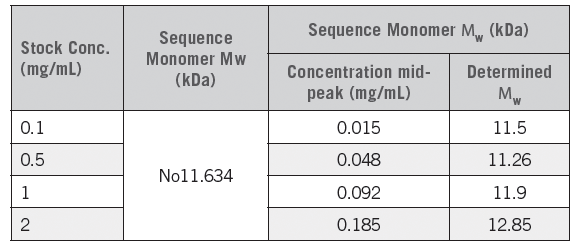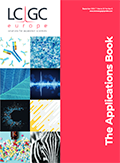Wyatt - Transient Protein Self-Association Determined by SEC-MALS
Domain antibodies (dAbs) are the smallest functional binding units of antibodies, corresponding to the variable regions of either the heavy (VH) or light (VL) chains of human antibodies. Different dAbs can show different degrees of self-association, which drives the need for a cheap, quick-yet robust-technique to study self-association behavior in drug discovery. This study outlines the use of size exclusion chromatography with multi-angle light scattering (SEC-MALS) to determine self-association properties, and validates the work by comparison with analytical ultracentrifugation (AUC).
Materials and Methods
A Shimazdu LC-20AD Prominence HPLC was used in series with miniDAWN® and Optilab® for this study. The columns used were TSK-GEL3000SWXL and Superdex S200. Data were collected and analyzed in ASTRA® software to determine weight-average molar mass at each concentration.

The dAb_1 sample was expressed, purified, and dialyzed into PBS, pH 7.4 and submitted to SEC-MALS and AUC. For MALS, the sample was concentrated to 2.4, 7.0, 75, and 130 mg/mL and followed by appropriate dilution to obtain nine different concentrations which were run on SEC-MALS (Table I).

The equilibrium dissociation constant for dimerization K2,1 was determined by plotting a graph of Mw versus log-concentration obtained from SEC-MALS mid peak.
Results and Discussion
Figure 1 shows the overlay of dRI and light scattering signals for five injections corresponding to stock concentrations from 5 mg/mL to 120 mg/mL (additional injections at lower concentration were also performed, per Table I). Dilution on the size-exclusion columns decreases the peak concentration by approximately seven-fold, and other areas of the peak have respectively lower concentrations.

Figure 1: Overlay of the five different sample results from SEC-MALS highlight-ing the a "Determined Mw." Samples with stock concentrations 5 mg/mL, 15 mg/mL, 30 mg/mL, 60 mg/mL, and 120 mg/mL, representing the smallest to biggest peaks respectively.
Due to dynamic monomer-dimer equilibrium, the molar mass determined by MALS is not uniform across the peak. For best accuracy, the calculations are performed using the concentration and molar mass values determined at the maximum of each peak. The K2,1 values for dAb_1 from SEC-MALS was calculated as 300 µM, comparing well to 391 µM from the AUC experiment.
While AUC is often considered the gold standard for the determination of self-association in solution, scientists are looking for alternatives due to AUC's high costs, low throughput and expertise requirements. Here, SEC-MALS has shown excellent agreement with AUC results and can be used as a cheaper, easier and quicker alternative.
Another light-scattering method that is suitable for characterization of transient self-association beyond monomer-dimer equilibrium is composition-gradient multi-angle light scattering (CG-MALS). With similar low cost and ease of use, CG-MALS provides extended analysis of self- and hetero-association, similar to equilibrium sedimentation by AUC.

Wyatt Technology Corp.
6330 Hollister Ave., Santa Barbara, CA 93110
tel. 1 (805) 681-9009
Website: www.wyatt.com

MALDI Guided SpatialOMx® Uncovers Proteomic Profiles in Tumor Subpopulations of Breast Cancer
September 1st 2020The timsTOF fleX system bridges a current gap by providing MALDI Imaging and in-depth proteomics analysis in just one instrument. The instrument offers all benefits of a timsTOF Pro for time-efficient and sensitive proteomics, combined with a high-resolution MALDI source and stage. Using PASEF technology, it is possible to retrieve high protein ID rates with small sample amounts. Here we present the new SpatialOMx® workflow to identify distinct proteomic profiles for different tumor subpopulations in breast cancer as an example for this powerful approach.

.png&w=3840&q=75)

.png&w=3840&q=75)



.png&w=3840&q=75)



.png&w=3840&q=75)










